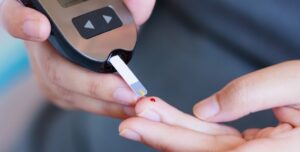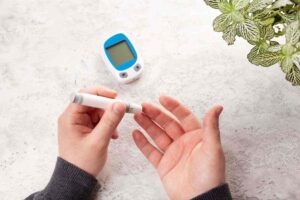Hyperglycemic coma, a life-threatening emergency, arises when blood sugar levels soar dangerously high. This condition, primarily associated with diabetes, demands immediate medical attention to prevent severe complications. Through this guide, we aim to shed light on the hyperglycemic coma treatment, including emergency medical approaches and most importantly, prevention tips. By educating ourselves and our loved ones about this serious condition, we can take proactive steps toward prevention and ensure timely intervention, potentially saving lives.
Contents
How To Know The Hyperglycemic Coma Emergency?
 Recognizing a hyperglycemic coma emergency is critical for timely intervention and can potentially save lives. A hyperglycemic coma, often resulting from extremely high blood glucose levels, can occur in people with diabetes, particularly if it’s poorly managed. Here are key signs and steps to recognize this emergency:
Recognizing a hyperglycemic coma emergency is critical for timely intervention and can potentially save lives. A hyperglycemic coma, often resulting from extremely high blood glucose levels, can occur in people with diabetes, particularly if it’s poorly managed. Here are key signs and steps to recognize this emergency:
- Extremely High Blood Sugar Levels: Blood glucose readings significantly above normal ranges are a primary indicator. Normal blood glucose levels are typically between 70-130 mg/dL fasting, and less than 180 mg/dL after meals. Levels much higher than these, especially persistently, warrant immediate attention.
- Increased Thirst and Urination: An early sign of hyperglycemia is polyuria (increased urination) and polydipsia (increased thirst), as the body tries to eliminate excess sugar through urine.
- Nausea and Vomiting: As the body becomes more acidic due to the breakdown of fats (in the case of diabetic ketoacidosis), nausea and vomiting can occur.
- Fatigue and Weakness: High blood sugar levels can lead to a significant decrease in energy, causing extreme tiredness and weakness.
- Shortness of Breath: A person might experience rapid breathing or shortness of breath, a condition known as Kussmaul respiration, particularly in diabetic ketoacidosis.
- Confusion and Altered Mental State: High blood sugar levels can affect mental functioning. And, leading to confusion, difficulty concentrating, or even unconsciousness.
- Fruity-Smelling Breath: In diabetic ketoacidosis, the body produces ketones. It can cause the breath to smell fruity or like nail polish remover.
Being aware of these signs and taking immediate action can prevent serious complications associated with a hyperglycemic coma. Always consult with a healthcare provider for guidance and treatment tailored to individual health needs.
How Do You Treat a Hyperglycemia Coma Emergency?
 Hyperglycemic coma treatment involves several critical steps and should always be conducted under medical supervision in a hospital setting. Here’s an overview of the treatment approach:
Hyperglycemic coma treatment involves several critical steps and should always be conducted under medical supervision in a hospital setting. Here’s an overview of the treatment approach:
Initial Assessment and Stabilization
Upon the patient’s arrival at a healthcare facility, a rapid medical assessment is paramount. Vital signs including blood pressure, heart rate, respiratory rate, and body temperature are immediately evaluated to ascertain the severity of the patient’s condition. Concurrently, blood and urine tests are conducted to accurately measure blood glucose levels, ketone presence, electrolyte levels, blood pH, and kidney function. These initial assessments provide a crucial baseline that guides the urgency and specificity of subsequent treatments.
Fluid Replacement
Fluid replacement therapy constitutes the cornerstone of initial treatment for a hyperglycemic coma. Dehydration in this context is profound, resulting from the osmotic diuresis induced by hyperglycemia, leading to significant fluid and electrolyte losses. Intravenous (IV) fluid administration, typically starting with saline solutions, is essential to correct dehydration and restore normal circulation volume. This not only helps to dilute the high concentration of blood glucose but also begins to correct electrolyte imbalances, particularly sodium and potassium deficits.
Insulin Therapy
Insulin therapy is another critical component, administered to gradually lower the dangerously high levels of blood glucose. This reduction must occur at a controlled rate to avoid precipitating cerebral edema, a potential complication from too rapid a decrease in blood glucose levels. Initially, insulin is delivered intravenously in a continuous infusion, allowing for precise adjustments based on regular monitoring of blood glucose levels.
Electrolyte Management
Electrolyte management is intricately linked with both fluid replacement and insulin therapy. Hyperglycemia-induced diuresis leads to significant losses of key electrolytes, with potassium being of particular concern due to its critical roles in cardiac function and muscle contraction. Potassium levels are meticulously monitored and supplemented as needed to prevent life-threatening complications such as cardiac arrhythmias.
Transition to Subcutaneous Insulin
Transitioning from IV insulin to subcutaneous injections marks a significant step in the patient’s stabilization. This phase begins once blood glucose levels are nearing target ranges and the patient can tolerate oral intake. The transition is carefully managed to maintain glucose control without precipitating hypoglycemia.
Overall, hyperglycemic coma treatment requires a comprehensive, multidisciplinary approach focused on immediate stabilization. Through vigilant monitoring, individualized care, and patient education, the goal is to restore the patient to health and prevent future emergencies.
How Can I Prevent Hyperglycmic Coma?
 Preventing a hyperglycemic coma involves careful management of diabetes and an understanding of the factors that can lead to this serious condition. Here are strategies to help prevent a hyperglycemic coma:
Preventing a hyperglycemic coma involves careful management of diabetes and an understanding of the factors that can lead to this serious condition. Here are strategies to help prevent a hyperglycemic coma:
Consistent Blood Sugar Monitoring
Regular monitoring of blood glucose levels provides valuable insights into your diabetes management. By keeping track of your blood sugar levels, you can identify trends, recognize patterns, and make timely adjustments to your treatment plan as needed. Consistency in monitoring, especially during periods of illness or stress, allows for early intervention to prevent hyperglycemia from escalating into a coma.
Adhere to Medication Regimens
Adhering to prescribed diabetes medications, including insulin injections or oral medications, is crucial for maintaining stable blood sugar levels. Skipping doses or deviating from your treatment plan can disrupt glycemic control and increase the risk of hyperglycemia. It’s essential to follow your healthcare provider’s instructions precisely and communicate any challenges or concerns you may have with your medication regimen.
Healthy Lifestyle Choices
A balanced diet, regular exercise, and healthy weight are fundamental pillars of diabetes management. Consuming a nutritious diet rich in fruits, vegetables, whole grains, and lean proteins helps regulate blood sugar levels and promotes overall health. Engaging in regular physical activity improves insulin sensitivity and contributes to better glycemic control, reducing the likelihood of hyperglycemic episodes.
Stay Hydrated
Adequate hydration is essential for individuals with diabetes to prevent dehydration and support proper kidney function. Drinking plenty of water throughout the day helps flush out excess glucose from the bloodstream, reducing the risk of hyperglycemia. Monitoring fluid intake, especially during hot weather or when experiencing illness, is important to prevent dehydration-induced complications.
Illness Management
Illnesses, infections, and other medical conditions can cause fluctuations in blood sugar levels, necessitating careful management for individuals with diabetes. During periods of illness, it’s crucial to monitor blood sugar levels more frequently, stay hydrated, and adhere to any adjustments in your treatment plan recommended by your healthcare provider.
Recognize Signs of High Blood Sugar
Awareness of hyperglycemia symptoms, such as increased thirst, frequent urination, fatigue, and blurred vision, enables prompt action to prevent further escalation. Monitoring for these warning signs allows individuals with diabetes to intervene early by adjusting their diet, and medications, or seeking medical attention when necessary.
Education and Awareness
Educating yourself and your loved ones about diabetes management and the signs of hyperglycemia is empowering. Understanding the importance of regular monitoring, medication adherence, and lifestyle modifications helps individuals with diabetes take proactive steps to prevent hyperglycemic emergencies.
Regular Healthcare Consultations
Scheduled appointments with your healthcare team provide opportunities to review your diabetes management plan, assess your progress, and address any concerns or challenges you may encounter. Healthcare professionals can offer guidance, make adjustments to your treatment regimen as needed, and provide ongoing support to help you achieve optimal glycemic control.
Emergency Plan
Having an emergency plan in place ensures preparedness in the event of a hyperglycemic crisis. This plan may include instructions for managing high blood sugar levels, contact information for healthcare providers, and steps for seeking emergency medical assistance if necessary. Wearing a medical alert identification can also alert others to your diabetes status in an emergency.
Avoid Skipping Meals
Maintaining regular meal patterns is essential for managing blood sugar levels and preventing hyperglycemia. Skipping meals can lead to fluctuations in blood glucose levels, particularly for individuals on insulin or certain diabetes medications. Eating balanced meals at consistent times helps stabilize blood sugar levels throughout the day.
Monitor for Ketones
 Individuals with type 1 diabetes should monitor for ketones in their urine, especially during periods of illness or when blood sugar levels are high. Ketone testing helps detect the presence of ketones, indicating a risk of diabetic ketoacidosis (DKA). Early detection allows for timely intervention to prevent DKA and potential progression to a hyperglycemic coma.
Individuals with type 1 diabetes should monitor for ketones in their urine, especially during periods of illness or when blood sugar levels are high. Ketone testing helps detect the presence of ketones, indicating a risk of diabetic ketoacidosis (DKA). Early detection allows for timely intervention to prevent DKA and potential progression to a hyperglycemic coma.
By incorporating these preventive measures into your daily routine and actively managing your diabetes, you can reduce the risk of hyperglycemic coma. It’s essential to work closely with your healthcare team to develop a personalized diabetes management plan.
Conclusion
In conclusion, effective hyperglycemic coma treatment and prevention, a life-threatening complication of diabetes, requires a multifaceted approach. Prompt recognition of symptoms, and immediate medical intervention in a hospital setting, including fluid replacement, insulin therapy, and electrolyte management, are crucial in stabilizing the patient’s condition. Furthermore, maintaining consistent blood sugar monitoring and being vigilant about early warning signs can significantly reduce the risk.
By implementing these strategies and working closely with healthcare providers, individuals can strive towards better glycemic control and overall well-being. Do you want to get rid of diabetes? Join our online diabetes treatment program and reverse Diabetes naturally through lifestyle changes such as a Personalized Diet plan, Exercise, Yoga, dieticians, and health coaches.

